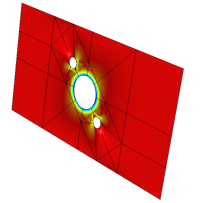The Cold Working Solver is perfect for a quick assessment of the 2D residual stresses after cold working a single hole via mandrel insertion/removal. The modeling requirements are minimal from the analyst, with the cold work process integrated within the Cold Working Solver. All that is specified by the user is which hole is cold worked, the definition of an elastic-plastic material, the mandrel material properties and the mandrel interference.
Cold Working Solver

The Cold Working Solver is an automated Planar analysis tool that simulates the cold working process via superposition and provides the analyst with the residual state of stress resulting from pulling an oversize mandrel through a fastener hole. It is intended to provide a fast and accurate solution for when reverse plasticity is not a concern. For cases of reverse plasticity, it is recommended to use the Non-Linear Solver.
Key Features and Advantages
There is minimal input required for the solver setup:
- The hole ID to be cold worked
- The mandrel material ID
- The mandrel diametric interference

Each of these solutions is available for post-processing.
- Mandrel insertion (local plasticity around the hole).
- Mandrel removal (CW residual stress).
- Final state of stress (CW residual + applied load).
The Cold Working Solver utilizes superposition to combine the effects of the loads and constraints with the effects of the cold working operation. The following steps describe a typical cold working analysis:
- Determination of the plastic zone due to mandrel insertion.
- Determination of the residual stresses due to mandrel removal.
- The solution corresponding to any specified loads.
- The combined solution, utilizing superposition, of the residual stresses and the specified loads.
Looking for Resources?
Recent News & Events
Quick Links
Testimonials
-
The software provides a highly reliable and user-friendly production stress analysis tool that will replace the Finite Element Method (FEM) tools and failure criteria the experts currently employ for analyzing bonded joints. The software includes an FEM-based handbook format, which allows non-experts to utilize models prepared by specialists. The handbook problems include built-in failure criteria, geometric and material nonlinearities, and the modern FEM technology provides better error control and the treatment of very large aspect ratios.”
Dr. Stephen P. Engelstad
Technical Fellow, Lockheed Martin Aeronautics Company, Structural Methods and Analysis
 Serving the Numerical Simulation community since 1989
Serving the Numerical Simulation community since 1989 





